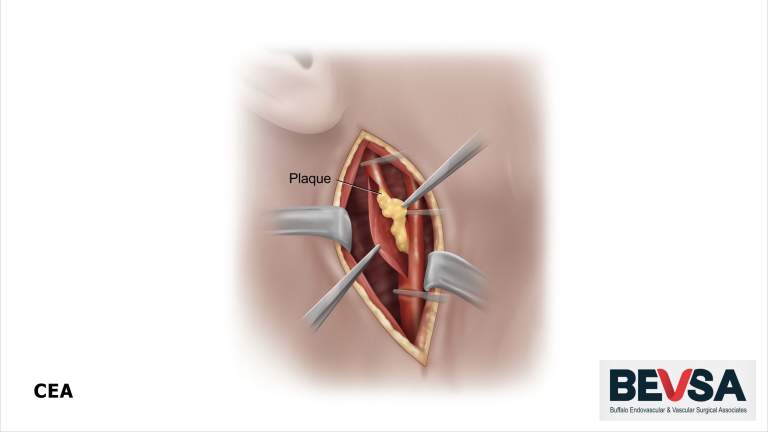Carotid Endarterectomy
Carotid Endarterectomy: An Open Surgical Option to Treat Carotid Disease
For patients with severe carotid disease, the carotid endarterectomy procedure (CEA) is a proven procedure that our surgeons at BEVSA have been performing and teaching for decades. The CEA procedure is an open surgical option tailored for our patients who are at a low surgical risk and/or do not qualify for a minimally invasive alternative.
Who is eligible for CEA?
The carotid arteries are responsible for supplying blood and oxygen to the brain. As plaque develops in the carotid artery, it can become a significant enough blockage to prevent blood flow to the brain and potentially cause a stroke. In addition, the plaque in the carotid artery can cause a stroke by breaking off and traveling to smaller blood vessels in the brain.
For patients without any signs or symptoms of stroke, your vascular surgeon will assess your carotid artery images to determine if the plaque in the carotid artery is significant enough to put you at high risk for stroke. Sometimes, patients may have had a recent stroke or Mini-stroke (TIA) and are found to have high amounts of plaque in the carotid artery. Both of these scenarios are referred to as severe carotid artery disease and usually warrant a carotid procedure to remove plaque and lessen the patient's risk of stroke.
Once your surgeon has determined that you are a candidate for a carotid artery procedure. They will assess your imaging studies, surgical risks, age, and medication list to determine if you are a better candidate for an open surgery (CEA) vs a minimally invasive stenting procedure. CEA is well suited for patients who are at low risk of surgical complications. In addition, vessel anatomy, location of plaque, and the amount of calcium in the artery may make a patient a better candidate for the CEA procedure.
Procedure Details
The surgery begins by making a 3-4-inch incision down the side of the neck to expose the affected carotid artery. Next, the carotid artery is clamped shut above and below the disease portion of the vessel. This prevents any blood from flowing into the diseased area as we open the artery and operate. After clamping the artery, we use forceps to carefully remove the plaque from the carotid artery to ensure that it does not break off in the future and cause a stroke.
Throughout the procedure, we utilize neuromonitoring technology to closely watch the brain's activity to detect any signs of stroke or in-procedure patient complications. Once all plaque is removed, a patch is sewn over the carotid artery and the clamps are removed. This allows blood to flow through the now widely open carotid artery which is free of plaque.
The procedure usually lasts about 2-3 hours at Gates Vascular Institute and most patients are put under general anesthesia and are discharged the following day. After the procedure, you are left with a 3-4inch incision down the side of the neck which will take a couple of months to heal. For more information about CEA, and to hear one of our surgeons explain the procedure, click on the video below.
Patient Stories
Here at BEVSA, we pride ourselves on engaging with our patient’s stories and feedback. The following stories help highlight how our superior vascular care and compassion translates from our office to improving the everyday lives of our patients. We hope these stories provide comfort to our patients and their families and illustrate how our team at BEVSA goes above and beyond for our patients everyday.
Denise's Experience with Carotid Surgery
Denise was diagnosed with carotid artery disease which put her at risk for stroke. She was then sent to our practice for evaluation and treatment. Watch the video to learn about Denise's journey with carotid disease at BEVSA and her experience with the carotid endarterectomy procedure.
Frequently Asked Questions
How Safe Is CEA?
The CEA procedure is a very well proven surgery that has been utilized and refined by vascular surgeons since the 1960s. It has plenty of data that shows it is a very effective long term solution at removing plaque from the carotid artery.
Will I feel any different after the procedure?
For some patients who have had a past history of stroke or TIA, the CEA procedure can help alleviate symptoms. However, for the majority of patients, this procedure is a preventative measure meant to reduce the risk of the patient developing a stroke in the future. Therefore, most patients report being back to their usual activity within a few days after the procedure.
Is it ever a problem that the carotid artery is being clamped during the procedure?
It’s rarely a problem because the brain has multiple arteries that supply it with blood. In addition, the critical part of the procedure, when the blood flow is blocked, only lasts about 10 minutes. The CEA procedure also utilizes neuromonitoring to assess the patient’s brain activity throughout the procedure to ensure the brain is receiving adequate circulation.
What are some common side effects after the procedure?
One of the most common reported side effects is mild numbness and tingling across the incision site and jawbone. This is because the nerves surrounding the carotid artery are temporarily stretched during the procedure. Most patients report that the altered sensations decrease over time. It can take about 6-12 months for complete resolvement as the nerves heal.
Why is it important to follow up with my physician multiple times after the procedure?
After your CEA procedure, it is important to continue seeing your vascular surgeon so they can examine your incision site and ultrasound scan your carotid artery to ensure there is not any significant, residual plaque. In addition, many patients that have had a carotid procedure also have disease in the other carotid artery which needs continuous monitoring and potential intervention to ensure the patient is at a decreased risk for stroke.
